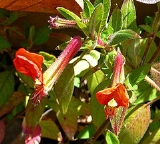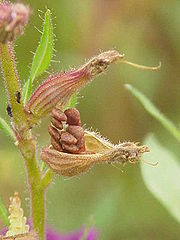
Cuphea
Encyclopedia

Genus
In biology, a genus is a low-level taxonomic rank used in the biological classification of living and fossil organisms, which is an example of definition by genus and differentia...
containing about 260 species
Species
In biology, a species is one of the basic units of biological classification and a taxonomic rank. A species is often defined as a group of organisms capable of interbreeding and producing fertile offspring. While in many cases this definition is adequate, more precise or differing measures are...
of annual
Annual plant
An annual plant is a plant that usually germinates, flowers, and dies in a year or season. True annuals will only live longer than a year if they are prevented from setting seed...
and perennial flowering plant
Flowering plant
The flowering plants , also known as Angiospermae or Magnoliophyta, are the most diverse group of land plants. Angiosperms are seed-producing plants like the gymnosperms and can be distinguished from the gymnosperms by a series of synapomorphies...
s native to warm temperate
Temperate
In geography, temperate or tepid latitudes of the globe lie between the tropics and the polar circles. The changes in these regions between summer and winter are generally relatively moderate, rather than extreme hot or cold...
to tropical regions of the Americas
Americas
The Americas, or America , are lands in the Western hemisphere, also known as the New World. In English, the plural form the Americas is often used to refer to the landmasses of North America and South America with their associated islands and regions, while the singular form America is primarily...
. The species range from low-growing herb
Herb
Except in botanical usage, an herb is "any plant with leaves, seeds, or flowers used for flavoring, food, medicine, or perfume" or "a part of such a plant as used in cooking"...
s to semi-woody shrub
Shrub
A shrub or bush is distinguished from a tree by its multiple stems and shorter height, usually under 5–6 m tall. A large number of plants may become either shrubs or trees, depending on the growing conditions they experience...
s up to 2 m tall. Commonly they are known as cupheas, or, in the case of some species, as cigar plants. The generic name is derived from the Greek
Greek language
Greek is an independent branch of the Indo-European family of languages. Native to the southern Balkans, it has the longest documented history of any Indo-European language, spanning 34 centuries of written records. Its writing system has been the Greek alphabet for the majority of its history;...
word κυφος (kyphos), meaning "bent," "curved," or "humped."
Botanist Shirley A. Graham, currently of the Missouri Botanical Garden
Missouri Botanical Garden
The Missouri Botanical Garden is a botanical garden located in St. Louis, Missouri. It is also known informally as Shaw's Garden for founder Henry Shaw, a botanist and philanthropist.-History:...
, has published widely on the genus. Among Graham's Cuphea contributions are two volumes in the series Systematic Botany Monographs.
Uses

Ornamental plant
Ornamental plants are plants that are grown for decorative purposes in gardens and landscape design projects, as house plants, for cut flowers and specimen display...
s or honey plants. C. ignea
Cuphea ignea
Cuphea ignea, also known as the Cigar plant, Cigar flower, Firecracker plant, or Mexican Cigar, is a tropical, perennial, densely-branched evergreen sub-shrub. This species, native to Mexico and the West Indies, produces small, tubular, bright red to orange flowers. Each flower is tipped with a...
'David Verity' and C. micropetalia are popular plants to attract hummingbird
Hummingbird
Hummingbirds are birds that comprise the family Trochilidae. They are among the smallest of birds, most species measuring in the 7.5–13 cm range. Indeed, the smallest extant bird species is a hummingbird, the 5-cm Bee Hummingbird. They can hover in mid-air by rapidly flapping their wings...
s.
Some species of Cuphea are used to produce cuphea oil
Cuphea oil
Cuphea oil is oil pressed from the seeds of several species of the genus Cuphea. Interest in cuphea oils is relatively recent, as a source of medium-chain triglycerides like those found in coconut oil and palm oil. Cuphea oil is of interest because it grows in climates where palms - the source of...
, of interest as sources of medium-chain triglyceride
Triglyceride
A triglyceride is an ester derived from glycerol and three fatty acids. There are many triglycerides, depending on the oil source, some are highly unsaturated, some less so....
s. For most purposes, cuphea oil is identical to coconut oil
Coconut oil
Coconut oil is an edible oil extracted from the kernel or meat of matured coconuts harvested from the coconut palm . Throughout the tropical world, it has provided the primary source of fat in the diets of millions of people for generations. It has various applications in food, medicine, and industry...
and palm oil
Palm oil
Palm oil, coconut oil and palm kernel oil are edible plant oils derived from the fruits of palm trees. Palm oil is extracted from the pulp of the fruit of the oil palm Elaeis guineensis; palm kernel oil is derived from the kernel of the oil palm and coconut oil is derived from the kernel of the...
; these are derived from strictly tropical plants however and – particularly in the latter case – the expanding production of which has caused a considerable amount of habitat destruction
Habitat destruction
Habitat destruction is the process in which natural habitat is rendered functionally unable to support the species present. In this process, the organisms that previously used the site are displaced or destroyed, reducing biodiversity. Habitat destruction by human activity mainly for the purpose of...
. Cuphea may thus produce a valuable source of income for farmers in temperate regions, and by supplementing coconut and palm oil to satisfy the growing demand (e.g. for biodiesel
Biodiesel
Biodiesel refers to a vegetable oil- or animal fat-based diesel fuel consisting of long-chain alkyl esters. Biodiesel is typically made by chemically reacting lipids with an alcohol....
production) at the same time decreasing the need for wholesale logging
Logging
Logging is the cutting, skidding, on-site processing, and loading of trees or logs onto trucks.In forestry, the term logging is sometimes used in a narrow sense concerning the logistics of moving wood from the stump to somewhere outside the forest, usually a sawmill or a lumber yard...
in tropical countries. Early attempts at commercial production have focused on an interspecific hybrid population derived from C. lanceolata
Cuphea lanceolata
Cuphea lanceolata, also known as the Cigar Flower, is a annual herbaceous flowering plant in the genus Cuphea, belonging to the Lythraceae family.-Description:...
and Clammy Cuphea (C. viscosissima
Cuphea viscosissima
Cuphea viscosissima, also known as blue waxweed, clammy cuphea or as "tarweed", is a plant native to the United States. It is a potential source of edible oil for humans....
).
Cuphea has also been shown to improve agricultural crops in North America when used in crop rotation
Crop rotation
Crop rotation is the practice of growing a series of dissimilar types of crops in the same area in sequential seasons.Crop rotation confers various benefits to the soil. A traditional element of crop rotation is the replenishment of nitrogen through the use of green manure in sequence with cereals...
. Crop rotation is commonly practiced among farmers to improve soil quality
Soil quality
The proposed a definition, stating that ' is an account of the soil’s ability to provide ecosystem and social services through its capacities to perform its functions under changing conditions...
, control host-specific pests, and decrease the use of fertilizers and pesticides. When cuphea was introduced into the crop rotation of corn and wheat, scientists from the Agricultural Research Service
Agricultural Research Service
The Agricultural Research Service is the principal in-house research agency of the United States Department of Agriculture . ARS is one of four agencies in USDA's Research, Education and Economics mission area...
of the USDA found that the addition of cuphea had positive effects on the following harvest, including a higher yield of crop and crops that are higher in protein.http://www.ars.usda.gov/is/pr/2010/100108.htm Such research reveals how cuphea can be used in agriculture to increase the profitability of crops like wheat and corn.
The seed oils of some species are very rich in one particular fatty acid
Fatty acid
In chemistry, especially biochemistry, a fatty acid is a carboxylic acid with a long unbranched aliphatic tail , which is either saturated or unsaturated. Most naturally occurring fatty acids have a chain of an even number of carbon atoms, from 4 to 28. Fatty acids are usually derived from...
. C. painteri oil, for example, is about three-quarters caprylic acid
Caprylic acid
Caprylic acid is the common name for the eight-carbon saturated fatty acid known by the systematic name octanoic acid. It is found naturally in the milk of various mammals, and it is a minor constituent of coconut oil and palm kernel oil...
; C. carthagenensis oil consists of about 80% lauric acid
Lauric acid
Lauric acid , the saturated fatty acid with a 12-carbon atom chain, is a white, powdery solid with a faint odor of bay oil or soap.-Occurrence:...
. C. koehneana oil may be the richest natural source of a single fatty acid, with 95% of its content consisting of capric acid.
Selected species


- Cuphea carthagenensis (Jacq.) J.F.MacBr.
- Cuphea cyanea DC.
- Cuphea decandra W.T.Aiton
- Cuphea epilobiifolia
- Cuphea hookeriana Walp.
- Cuphea hyssopifoliaCuphea hyssopifoliaCuphea hyssopifolia, also known as False Heather, Mexican Heather, Hawaiian Heather or Elfin Herb is a small shrub which is native to Mexico, Guatemala and Honduras...
KunthCarl Sigismund KunthCarl Sigismund Kunth , also Karl Sigismund Kunth or anglicized as Charles Sigismund Kunth, was a German botanist...
– False Heather, Mexican Heather - Cuphea igneaCuphea igneaCuphea ignea, also known as the Cigar plant, Cigar flower, Firecracker plant, or Mexican Cigar, is a tropical, perennial, densely-branched evergreen sub-shrub. This species, native to Mexico and the West Indies, produces small, tubular, bright red to orange flowers. Each flower is tipped with a...
A.DC. - Cuphea ingrata Cham. et Schltdl.
- Cuphea jorullensis Kunth
- Cuphea koehneana Rose
- Cuphea laminuligera Koehne
- Cuphea lanceolataCuphea lanceolataCuphea lanceolata, also known as the Cigar Flower, is a annual herbaceous flowering plant in the genus Cuphea, belonging to the Lythraceae family.-Description:...
W.T.Aiton - Cuphea linarioides Cham. et Schltdl.
- Cuphea llavea Lex. – Bat-faced Cuphea
- Cuphea lutea Rose
- Cuphea lutescens Hoehne
- Cuphea melvilla Lindl.
- Cuphea mesostemon Koehne
- Cuphea micropetala Kunth
- Cuphea nudicostata
- Cuphea painteri Rose
- Cuphea procumbens Ortega
- Cuphea salvadorensis (Standl.) Standl.
- Cuphea speciosa Mart.
- Cuphea strigulosa
- Cuphea viscosissimaCuphea viscosissimaCuphea viscosissima, also known as blue waxweed, clammy cuphea or as "tarweed", is a plant native to the United States. It is a potential source of edible oil for humans....
Jacq. – Clammy Cuphea, Blue Waxweed, "tarweed" - Cuphea wrightii A.Gray

